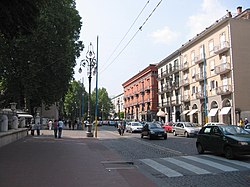Bellizzi Irpino
| Avellino | ||
|---|---|---|
| Comune | ||
| Comune di Avellino | ||

Corso Vittorio Emanuele
|
||
|
||
| Location of Avellino in Italy | ||
| Coordinates: 40°55′00″N 14°47′20″E / 40.91667°N 14.78889°ECoordinates: 40°55′00″N 14°47′20″E / 40.91667°N 14.78889°E | ||
| Country | Italy | |
| Region | Campania | |
| Province / Metropolitan city | Avellino (AV) | |
| Frazioni | Bellizzi Irpino, Pianodardine, Picarelli, Valle-Ponticelli | |
| Government | ||
| • Mayor | Paolo Foti | |
| Area | ||
| • Total | 30.55 km2 (11.80 sq mi) | |
| Elevation | 348 m (1,142 ft) | |
| Population (31 December 2013) | ||
| • Total | 55,448 | |
| • Density | 1,800/km2 (4,700/sq mi) | |
| Demonym(s) | Avellinesi | |
| Time zone | CET (UTC+1) | |
| • Summer (DST) | CEST (UTC+2) | |
| Postal code | 83100 | |
| Dialing code | 0825 | |
| Patron saint | St. Modestinus | |
| Saint day | 14 February | |
| Website | Official website | |
Avellino [avelˈliːno] ![]() listen is a town and comune, capital of the province of Avellino in the Campania region of southern Italy. It is situated in a plain surrounded by mountains 50 kilometres (31 mi) northeast of Naples and is an important hub on the road from Salerno to Benevento.
listen is a town and comune, capital of the province of Avellino in the Campania region of southern Italy. It is situated in a plain surrounded by mountains 50 kilometres (31 mi) northeast of Naples and is an important hub on the road from Salerno to Benevento.
Before the Roman conquest, the ancient Abellinum was a centre of the Samnite Hirpini, located on the Civita hill some 4 kilometres (2 mi) outside the current town, in what is now Atripalda. The city could correspond to the ancient Velecha, documented by coins found in the area. Abellinum was conquered by the Romans in 293 BC, changing name several times in the following centuries (Veneria, Livia, Augusta, Alexandriana, and Abellinatium). However, the edification of a true Roman town occurred only after the conquest by Lucius Cornelius Sulla in 89 BC.
The town was Christianized around 500 AD, becoming an episcopal seat. There followed the invasions of the Goths and Vandals. After the Lombard conquest of southern Italy, the ancient city was abandoned (it is disputed if completely or partly), and a new settlement grew on the Terra hill, corresponding to the modern Avellino. Defended by a castle, it became part of the Duchy (later Principality) of Benevento and, after the latter's fall, of the Principality of Salerno.
...
Wikipedia


